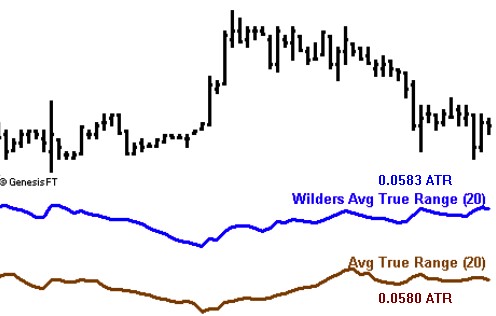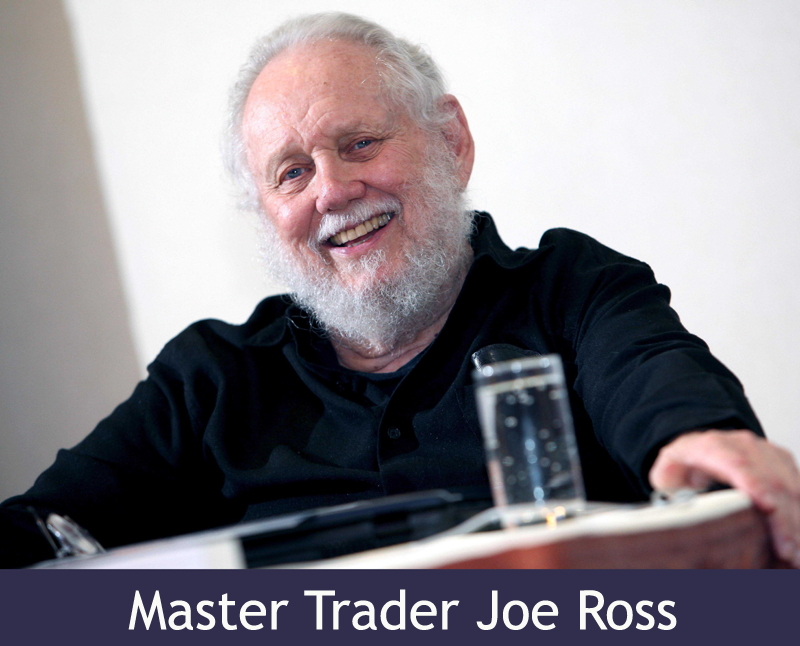Edition 974
April 14, 2023

Let's Learn the Art of Trading Joe Ross' Way!

"Trading is a battle against the bewitchment of our intelligence by means of an oscillator." -- Master Trader Joe Ross
Extended Savings - Don't Miss Out!
Enjoy 40% Off Selected eBooks

Click on the Links Below and Use Coupon Code During Checkout: extend40

Master Trader Joe Ross
Author, Trader, Trading Mentor, and Founder of Trading Educators, Inc.
Developer of Instant Income Guaranteed
Chart Scan with Commentary: Average True Range

A question came in a few days ago asking about ATR, and how it fits into The Law of Charts (TLOC).
Please realize that TLOC is not a trading method or a trading system. It is the foundation upon which price charts are built. TLOC describes human reaction to the movement of prices by defining certain formations. The simplest manifestation of price is seen in the form of a simple bar chart. You can’t get much simpler than a single price bar stripped of any open or close, nothing more than a vertical line depicting a range of values from high to low. No other form of chart can approach that level of simplicity.
ATR takes the value of the range of any number of those bars from high to low and averages them to determine the volatility in the market. The value of a single bar’s volatility is determined by taking the difference between the low the high.
Be aware that there is more than one way to determine the value. The simplest is high - low, but that fails to take into consideration any gaps. If you want to include the value of gaps, then you are faced with a problem. It is the decision as to how to treat gaps that is the main reason why different software algorithms arrive at different answers for the value of the ATR.
Picture, if you will, two price bars, with the second one gapping up in its entirety above the high of the first price bar. How you treat such a gap will be the main factor in the answer you get for ATR. Did prices move:
- From the low of bar 1 to the high of bar 2?
- From the close of bar 1 to the high of bar 2?
- From the high of bar 1 to the high of bar 2?
- From the low of bar 1 to the low of bar 2?
- From the close of bar 1 to the close of bar 2?
- From the open of bar 1 to the open of bar 2?
- From the open of bar 1 to the high of bar 2?... Etc.
Obviously, I left out a few other possibilities. But which one is correct? It turns out to be mostly a matter of opinion.
There are other factors that determine the reading for ATR that you see on your software:
- How many decimal points are included in the value? The chart above shows 4 decimal places.
- How does the software do the rounding?
- How many bars are included in the computation?
The chart above shows ATR as computed by Genesis Trade Navigator on a ten-minute chart utilizing 20 bars (brown line). The blue line is the way Trade Navigator computes “Wilder’s ATR.” But even that is not the same as the way others do it. There are times when the two are substantially different from one another, and substantially different from the calculation of others.
What is a trader to do? Should you aggravate about the way the software you use calculates ATR? There’s an old saying I heard in Texas: “Dance with the one that brung ya.” In other words, use whatever there is in the software you are currently using.
© by Joe Ross. Re-transmission or production of any part of this material is strictly prohibited without the prior written consent of Trading Educators, Inc.

Master Trader Joe Ross
Author, Trader, Trading Mentor, and Founder of Trading Educators, Inc.
Developer of Instant Income Guaranteed
Trading Article: The Cynic and the Realist
In the trading business, it's prudent to take everything you hear with a grain of salt. Our field is full of false prophets who claim they can make you rich quickly and easily. Realistic skepticism is healthy. For example, there are many traders who made huge profits in the late 90s, and now claim that they can help you live comfortably by trading a $10,000 account. How do you do it? It's easy, they claim. All you have to do is buy 200 shares of a $50 stock, wait for it to go up $1, and make a $200 profit in as little as 30 minutes. That's $400 an hour, $800,000 a year. Is this realistic? It doesn't seem to be. Sure, you can invest $10,000 on one trade, pick a stock that goes...read more.
© by Joe Ross. Re-transmission or reproduction of any part of this material is strictly prohibited without the prior written consent of Trading Educators, Inc.

Professional Trader Andy Jordan
Educator for Spreads, Options, Swing, and Day Trading, and Editor for 20+ years with Traders Notebook, daily advisory newsletter.
Trading Article: Recommended Time Frames
I've received the following question:
I assume the Ross Hook (RH) and Traders Trick Entry (TTE) are applicable in whatever time frame the trader uses. However, there are some time frames that are simply too erratic or wild to trade. And pertaining to stop running, there must be some that are favorites of those attempting to do so. So is there a recommended time interval from which to trade, or is it based on trader preference and risk?
Answer...read more.
by Andy Jordan. Re-transmission or reproduction of any part of this material is strictly prohibited without the prior written consent of Trading Educators, Inc.

Professional Trader Marco Mayer
Educator for Forex, Futures and Systematic Trader
Creator of Ambush Trading Method, Ambush Signals, and Head of AlgoStrats.com
Trading Article: Position Sizing / Measuring Performance
About a year ago I wrote an article about measuring performance where I explained the concept of measuring trading performance in Rs instead of $s. Everyone who trades for a while quickly realizes that $s don't really say too much about performance. You made $10? Maybe great. You made $50.000? Maybe not so good. The question always is in relation to what? What account size does the trader have, and more importantly, what was the risk of the trade compared to the profit (or loss).
Still I keep on seeing everyone talk about and get excited when they see the $$$$$$$. And I get it, at the end that's what counts right? But does it really help you to see...read more.
by Marco Mayer. Re-transmission or reproduction of any part of this material is strictly prohibited without the prior written consent of Trading Educators, Inc.
The Ambush Trading System was created in 2009 by Marco Mayer. Since then it proved itself in the markets for over a decade and did so with exceptional results. It's the only trading system we're aware of that is still going strong after so many years. While Ambush is a day trading system, meaning you will always enter and exit on the same trading day - you don't have to sit in front of your trading screen. You simply place your entry orders when the trading session starts and come back at the close!
by Marco Mayer. Re-transmission or reproduction of any part of this material is strictly prohibited without the prior written consent of Trading Educators, Inc.
Even though Master Trader Joe Ross passed away September 7, 2021, his trading knowledge of over 60 years will carry a trading legacy and will live on. As you learn about Joe Ross and understand what he was trying to teach his students, you will find that within his writings, he had a very special gift. Most importantly, it was his students that kept him striving to provide comprehendable trading material to actually teach traders and become independent, to rely on anyone, but themselves.
Joe Ross has been trading and investing since his first trade at the age of 14, and is a well known Master Trader and Investor. He was able to survive all the up and downs of the markets because of his adaptable trading style, using a low-risk approach that produces consistent profits.
Joe Ross is the creator of the Ross hook™, and has set new standards for low-risk trading with his concepts of "The Law of Charts™" and the "Traders Trick Entry™." Joe was a private trader and investor for much of his life, but a serious health situation in the late 80's caused him to shift his focus, and that is when he decided to share his knowledge. After his recovery, he founded Trading Educators in 1988, to teach aspiring traders how to make profits using his trading approach.
Joe Ross has written twelve major books and countless articles and essays about trading. All his books have become classics, and have been translated into many different languages. His students from around the world number in the thousands. His file of letters containing thanks and appreciation from students on every continent is huge: As one student, a successful trader, wrote: "Your mastery of teaching is even greater than my mastery of trading".
Joe Ross holds a Bachelor of Science degree in Business Administration from the University of California at Los Angeles. He did his Masters work in Computer Sciences at the George Washington University extension in Norfolk, Virginia. He is listed in "Who's Who in America." After 5 decades of trading and investing, Joe Ross still tutors, teaches, writes, and trades regularly. Joe is an active and integral part of Trading Educators. He is the founder and contributor of the company's newsletter Chart Scan™.
Joe's philosophy for helping traders is:
"Teach our students the truth in trading - teach them how to trade."
"Give them a way to earn while they learn - realizing that it takes time to develop a successful trader."
Joe sets forth the mission of Trading Educators as follows:
To show aspiring futures traders the truth in trading by teaching them how to read a chart so that they can successfully trade what they see, and by revealing to them all of the insider knowledge they need in order to understand the markets.
To enable them to trade profitably by training them to properly manage their trades as well as their mindset and self-control.
To accomplish our mission for our students we educate them so that they know and understand:
Benefits for our Clients:
- Where prices are likely to move next.
- Independence from complicated trading methods, magic indicators, and black-box systems.
- Independence from opinion, anyone's opinion, including their own.
- Independence achieved through knowing how to read a chart.
- Independence through having knowledge of insider actions.
- Independence achieved by taking holistic and eclectic approaches.
- Independence coming from knowing how to manage both the trades and themselves.
- Independence because they understand and trade what they see.
- Independence because they have learned how and why prices move as they do, through studying the truth in trading and the truth about markets.
Students learn only proven methods and techniques, which helps them to preserve capital and create more consistent profits; they are offered simple methods that will assist them to earn while they learn.
- They learn to work smarter and more effectively.
- They learn to treat trading as a business; we offer no Holy Grail or magic systems.
- They learn to adapt to changing market conditions.
- They learn a systematic approach to trading rather than a mechanical system for trading.
- Why prices will move there.
- Who and what cause prices to move.
- How far prices are likely to move when they do move.
- Their own role in the movement of prices..
- How to take advantage of the knowledge they receive.
- How to properly manage and exit a trade which they have entered.
- How to manage themselves and acquire the discipline needed to become successful traders.
Read some personal testimonials which Joe has received.
WE APPRECIATE YOUR TRUST IN US AND THANK YOU FOR YOUR BUSINESS!
Check out our Blog!
To view previous published Chart Scan newsletters, please click on the "newsletter" button located at the top of our website.
A WEALTH OF INFORMATION & EDUCATION:
Joe Ross-Trading Educators' popular free Chart Scan Newsletter has been published since 2004.
Note: Unless otherwise noted, all charts used in Chart Scan commentary were created by using Genesis Financial Technologies' Trade Navigator (with permission).
Legal Notice and Copyright 2023 Disclaimer - Published by Trading Educators, Inc.
Chart Scan is a complimentary educational newsletter.
Dear Traders,
Master Trader Joe Ross passed away September 2021, and prior years he was continously sending me folders filled with Chart Scan and Trading Articles. The emails would be titled "More to follow" and I would reply, "Keep'em coming". I am calling these lessons "hidden vault" material because if Joe were still alive, this is exactly what would be shown in your inbox every Friday morning. This is not regurgitated material; this is new stuff written by Joe or as he would refer to it with such passion, "This is good stuff".
As we continue to receive newsletter sign ups, new students from every continent will start to learn trading Joe's way especially in this challenging market. This is where he would reinforce to his students, yes, that includes you, that learning to trade is possible even in this environment, "A chart, is a chart, is a chart". His writings will stand the test of time to provide teaching lessons and guidance.
The proceeds of Trading Educators will continue to support Joe's wife, Loretta, of 62 years of marriage, which she is our number one priority. We thank everyone with continued support and prayers for her well-being in late stages of dementia.
As expressed in the past editions, the trading world has lost a unique and passionate trader and his material will continue to be relevant. Let's start learning to trade Joe Ross' way with our future Chart Scan publications. I am here to help, so feel free to email me with any comments, questions or concerns.
This newsletter and future publications are created to keep Master Trader Joe Ross' lessons readily available to traders that want to learn and improve their skills. My father passed away on September 7, 2021 and will be greatly missed, but his writings will stand the test of time for generations to come. Take it to heart and learn from the best through Master Trader Joe Ross' trading examples and articles which have impacted thousands of traders on every continent for over 60 years.
Happy trading,

Martha Ross-Edmunds
© by Trading Educators, Inc. Re-transmission or reproduction of any part of this material is strictly prohibited without prior written consent




